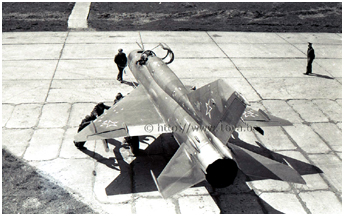
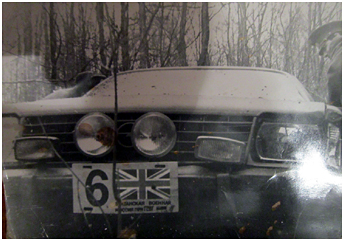 Damgarten Soviet airfield was located on the Baltic Sea coast northeast of the city of Rostock. It was naturally a target for the "air teams"
from the allied military liaison missions. However, the airfield was located inside a Permanent Restricted Area (PRA) and the "missionaries"
were not welcome there, to say the least. Should the latter be caught inside a PRA, they could be declared "persona non grata" by the Soviet
authorities and, consequently, their "propusk" (pass) would be taken back, thus ending their assignment as a liaison personnel in the GDR.
The 773rd Fighter Aviation Regiment (IAP) flying MiG-21bis and the 65th Independent Target-Towing Aviation Squadron (OBAE) equipped with Il-28
were stationed at the Damgarten airbase in March 1982. A second target-towing squadron, the 74.OBAE moved from Parchim to Damgarten sometime
during the same year (see > The target-towing units).
Moreover, units based in the GDR or in other Warsaw Pact countries would regularly deploy to Damgarten for live air-to-air firing training above
the Baltic Sea firing range, located east of Rügen Island. Consequently, this Soviet airfield was a choice target provided that the area was
visited at the right time. But, it was a difficult target to cover due to its location.
Damgarten Soviet airfield was located on the Baltic Sea coast northeast of the city of Rostock. It was naturally a target for the "air teams"
from the allied military liaison missions. However, the airfield was located inside a Permanent Restricted Area (PRA) and the "missionaries"
were not welcome there, to say the least. Should the latter be caught inside a PRA, they could be declared "persona non grata" by the Soviet
authorities and, consequently, their "propusk" (pass) would be taken back, thus ending their assignment as a liaison personnel in the GDR.
The 773rd Fighter Aviation Regiment (IAP) flying MiG-21bis and the 65th Independent Target-Towing Aviation Squadron (OBAE) equipped with Il-28
were stationed at the Damgarten airbase in March 1982. A second target-towing squadron, the 74.OBAE moved from Parchim to Damgarten sometime
during the same year (see > The target-towing units).
Moreover, units based in the GDR or in other Warsaw Pact countries would regularly deploy to Damgarten for live air-to-air firing training above
the Baltic Sea firing range, located east of Rügen Island. Consequently, this Soviet airfield was a choice target provided that the area was
visited at the right time. But, it was a difficult target to cover due to its location.
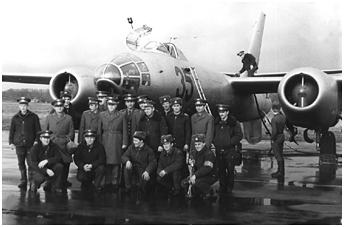
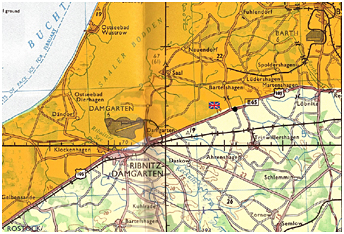 On March 15, 1982, an air team tour from the British Commanders'-in-Chief Mission to the Soviet Forces in Germany (BRIXMIS) had ventured
inside the PRA a few kilometers from the east end of the Damgarten runway, hoping to observe a flying program. The crew of car n°6, an Opel
Senator, was composed of Flight Lieutenant W. Crawford, tour officer, along with Master Air-Load Master (MALM) A. R. Johnson and the driver,
Corporal P. M. Anderson. The small group had found an observation point (OP) near a wood; however, after 45 minutes in place, the British team
decided to move to a new OP as a security measure. Nevertheless, this wise decision would not bring luck to them, quite the opposite!
While they were moving to a new OP, the Opel bogged down, necessitating the use of a hand winch (standart equipment in all mission cars)
to extricate the car from that embarassing position.
According to the BRIXMIS report about that incident, the tour team was spotted by a VOPO (Volkspolizei - Peoples's Police), while they were
attempting to winch the car. The version of Svyatoslav Nichiporets is different. The latter was assigned to the 485th Independent Radar Battalion
(OTRB) that was stationed south of the airfield, next to the 631st Radar Post (RLP) (see this > Photo).
On March 15, 1982, an air team tour from the British Commanders'-in-Chief Mission to the Soviet Forces in Germany (BRIXMIS) had ventured
inside the PRA a few kilometers from the east end of the Damgarten runway, hoping to observe a flying program. The crew of car n°6, an Opel
Senator, was composed of Flight Lieutenant W. Crawford, tour officer, along with Master Air-Load Master (MALM) A. R. Johnson and the driver,
Corporal P. M. Anderson. The small group had found an observation point (OP) near a wood; however, after 45 minutes in place, the British team
decided to move to a new OP as a security measure. Nevertheless, this wise decision would not bring luck to them, quite the opposite!
While they were moving to a new OP, the Opel bogged down, necessitating the use of a hand winch (standart equipment in all mission cars)
to extricate the car from that embarassing position.
According to the BRIXMIS report about that incident, the tour team was spotted by a VOPO (Volkspolizei - Peoples's Police), while they were
attempting to winch the car. The version of Svyatoslav Nichiporets is different. The latter was assigned to the 485th Independent Radar Battalion
(OTRB) that was stationed south of the airfield, next to the 631st Radar Post (RLP) (see this > Photo).
The 485.ORTB had four RLP under its command (> LINK):
- 631.RLP at Damgarten
- 632.RLP at Dranske (Rügen Island - to the north-east)
- 633.RLP at Thiessow (Rügen Island - to the south-east)
- 634.RLP at Warthe (Usedom) until 1979, then at Pasewalk
> MAP
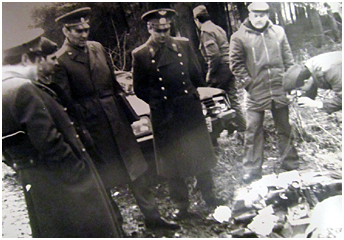
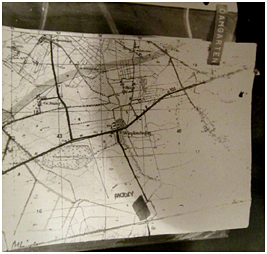 Asked about the circumstances of this incident, S. Nichiporets told us: "The mission got stuck in a clear cutting area in the woods 12 kilometers
from the city of Ribnitz-Damgarten, near the airfield beacon. The collective farm chairman, an acquaintance, called me. I was the unit duty officer.
It was the Special Section [i.e. the KGB counter-intelligence section] that went there to carry out the detention."
According to Mark Prüfer (1), the vehicle went inside the Behrenshägner woods at 11H00.
They were spotted by a team from the Stasi's 8th Department (MfS HA VIII (2)), disguised in NVA uniforms
that was there keeping watch on the area. The latter warned the Soviets about the British mission presence and a coordinated detention took place a half-hour later.
The different versions do not strictly match; however, they are not necessarily contradictory.
It is quite possible that each actor mentioned took part to this action or perhaps, for example, there may have been confusion between the VOPO
and the Stasi agents dressed in NVA uniforms.
The Soviet response team arrived on foot. The tour officer and the MALM were outside their car, trying to dig out the vehicle. S. Nichiporets goes on:
"They were bogged down and two crew members went to find a tractor [hence the collective farm chairman call?]. To use weapons or even to carry them
[in these circumstances] was prohibited. Therefore, when the driver in the vehicle opened [most probably unlocked] the door to let the others in, at that
time we stuck a shovel handle in the door and they had to remain outside of the vehicle: they would have had a form of diplomatic immunity in the locked vehicle."
The BRIXMIS annual report (BRX 404/1 Incident 6007/82) is slightly different and more explicit: "Soviet troops on foot detained the Tour.
Subsequently a Soviet Lieutenant Colonel arrived, describing himself as an Officer of the Rostock UV 09 [map reference] Komendatura.
The Tour Officer checked his pass and noted it was different from that shown by another Soviet Air Force Lieutenant Colonel. The Tour Officer
obeyed the apparent, Commandant's instruction to get out of the vehicle. When the door was unlocked [the shovel handle episode?], the Tour Officer
was dragged out and struck and the Tour equipment confiscated. A second Lieutenant Colonel arrived subsequently and identified himself as the Rostock
Commandant [the Komendatura chief]. There was dissent between this officer and the Air Force personnel present."
Asked about the circumstances of this incident, S. Nichiporets told us: "The mission got stuck in a clear cutting area in the woods 12 kilometers
from the city of Ribnitz-Damgarten, near the airfield beacon. The collective farm chairman, an acquaintance, called me. I was the unit duty officer.
It was the Special Section [i.e. the KGB counter-intelligence section] that went there to carry out the detention."
According to Mark Prüfer (1), the vehicle went inside the Behrenshägner woods at 11H00.
They were spotted by a team from the Stasi's 8th Department (MfS HA VIII (2)), disguised in NVA uniforms
that was there keeping watch on the area. The latter warned the Soviets about the British mission presence and a coordinated detention took place a half-hour later.
The different versions do not strictly match; however, they are not necessarily contradictory.
It is quite possible that each actor mentioned took part to this action or perhaps, for example, there may have been confusion between the VOPO
and the Stasi agents dressed in NVA uniforms.
The Soviet response team arrived on foot. The tour officer and the MALM were outside their car, trying to dig out the vehicle. S. Nichiporets goes on:
"They were bogged down and two crew members went to find a tractor [hence the collective farm chairman call?]. To use weapons or even to carry them
[in these circumstances] was prohibited. Therefore, when the driver in the vehicle opened [most probably unlocked] the door to let the others in, at that
time we stuck a shovel handle in the door and they had to remain outside of the vehicle: they would have had a form of diplomatic immunity in the locked vehicle."
The BRIXMIS annual report (BRX 404/1 Incident 6007/82) is slightly different and more explicit: "Soviet troops on foot detained the Tour.
Subsequently a Soviet Lieutenant Colonel arrived, describing himself as an Officer of the Rostock UV 09 [map reference] Komendatura.
The Tour Officer checked his pass and noted it was different from that shown by another Soviet Air Force Lieutenant Colonel. The Tour Officer
obeyed the apparent, Commandant's instruction to get out of the vehicle. When the door was unlocked [the shovel handle episode?], the Tour Officer
was dragged out and struck and the Tour equipment confiscated. A second Lieutenant Colonel arrived subsequently and identified himself as the Rostock
Commandant [the Komendatura chief]. There was dissent between this officer and the Air Force personnel present."
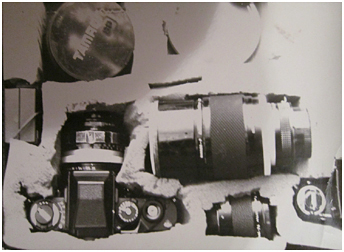
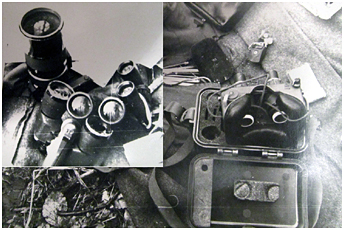 Mark Prüfer, whose story is based on the Stasi reports, says that later, one of the British military tried to re-enter the car. He was, however,
prevented from doing so by the Soviets [could this be the episode about the tour officer being extracted from the vehicle by force?].
Once the tour crew was out of the car, the Soviet and East German snatch group removed the vehicle's contents. The material related to the
Mission's work such as cameras, films, binoculars, night vision goggles, voice recorders, maps, notes etc. (3)
was confiscated by the Soviets. Personal effects or things unrelated to intelligence work were subsequently returned to their owners.
The BRIXMIS team then went to the Komendatura to be interrogated according to the usual procedures during detentions.
S. Nichiporets adds: "Naturally, they did not sign any statements [Akt]. Only the captain, I think he was the senior mission individual,
in perfect Russian said at the end: 'I'm fucked! I'll be home soon.'"
The detention ended at 20H20 when the reconnaissance team was allowed to leave. Their vehicle had been towed out of the woods by the Soviets.
They crossed the Glienicke bridge at 22H21.
Mark Prüfer, whose story is based on the Stasi reports, says that later, one of the British military tried to re-enter the car. He was, however,
prevented from doing so by the Soviets [could this be the episode about the tour officer being extracted from the vehicle by force?].
Once the tour crew was out of the car, the Soviet and East German snatch group removed the vehicle's contents. The material related to the
Mission's work such as cameras, films, binoculars, night vision goggles, voice recorders, maps, notes etc. (3)
was confiscated by the Soviets. Personal effects or things unrelated to intelligence work were subsequently returned to their owners.
The BRIXMIS team then went to the Komendatura to be interrogated according to the usual procedures during detentions.
S. Nichiporets adds: "Naturally, they did not sign any statements [Akt]. Only the captain, I think he was the senior mission individual,
in perfect Russian said at the end: 'I'm fucked! I'll be home soon.'"
The detention ended at 20H20 when the reconnaissance team was allowed to leave. Their vehicle had been towed out of the woods by the Soviets.
They crossed the Glienicke bridge at 22H21.
Epilogue
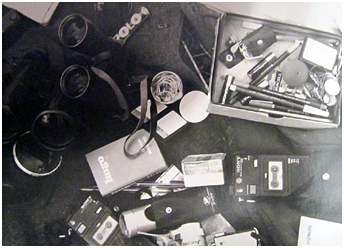 On March 17, Brigadier John Learmont, Chief BRIXMIS, met Lieutenant-Colonel Robert Polozov, Chief, Soviet External Relation Branch (SERB),
in Potsdam, the Soviet liaison office for the allied Missions. Chief BRIXMIS called into question the credibility of Komendatura staff that had colluded
in the use of violence and that other Soviet personnel had practised deceit in misrepresenting themselves as Komendatura personnel. Chief SERB countered by presenting
a letter from Army General Mikhail M. Zaitsev, Commander-in-Chief (CINC) GSFG, to the British Army of the Rhine (BAOR) Chief of Staff, in which he protested that
a PRA had been infringed.
On March 17, Brigadier John Learmont, Chief BRIXMIS, met Lieutenant-Colonel Robert Polozov, Chief, Soviet External Relation Branch (SERB),
in Potsdam, the Soviet liaison office for the allied Missions. Chief BRIXMIS called into question the credibility of Komendatura staff that had colluded
in the use of violence and that other Soviet personnel had practised deceit in misrepresenting themselves as Komendatura personnel. Chief SERB countered by presenting
a letter from Army General Mikhail M. Zaitsev, Commander-in-Chief (CINC) GSFG, to the British Army of the Rhine (BAOR) Chief of Staff, in which he protested that
a PRA had been infringed.
On April 7, a second meeting was held in order to present the response from General Sir Nigel Bagall, CINC BAOR. His letter treated the alleged infringement of PRA as a
matter of interpretation of the current PRA map (4) and stated that there were no intended penetrations.
He protested at the use of violence condoned by an officer of the Komendatura. Chief SERB, having read the letter made the following remarks:
- There were no questions and probably would be no reply;
- Negociations should be verbal and not involve violence;
- Questions were best solved at the Chief level.
Chief SERB then extended an invitation to lunch.
notes
(1)
Author of "Auf Spionage Tour" - BOD Books on Demand, Norderstedt, 2011. ISBN 978-3-8423-6053-2
(2)
The HA VIII departement (HA - Hauptabteilung) from the Ministry for State Security (MfS - Ministeriums für Staatssichereit or Stasi) was, among other
tasks, responsible for keeping track of the allied military liaison missions
(Consult this > File).
(3)
The material was seized by the Soviets; however, the Germans had time to list it for their own archives. The list included among others:
- ITT night vision goggles
- 3 Nikon cameras, one motor drive, one flash
- 85, 180 and 1000 mm lenses, a focal length doubler and filters
- 29 exposed 400 ASA Kodak films, 7 Ektachrome films and 30 black and white 400 ASA Ilford films still packed
- 3 binoculars of different focal lengths
- 3 voice recorders
- 1 PRA map
- 9 maps of military targets
- maps of northern GDR and gas stations map
- list of known MfS vehicles registration plates
- notes, batteries etc.
(4) Bill Burhans (USMLM 1971-75 / 1979-80) comments:
"The Soviets delivered a map to each of the missions and, during my tenure on the Air Team, these
maps differed. Thus, the French could safely go places that neither the Brits or we Amis could go. BRIXMIS took
on the project of preparing a map
that took advantage of any differences that could be considered to be in our favor. Fun and games all around!"
 |
Plan du site - Sitemap |  |
